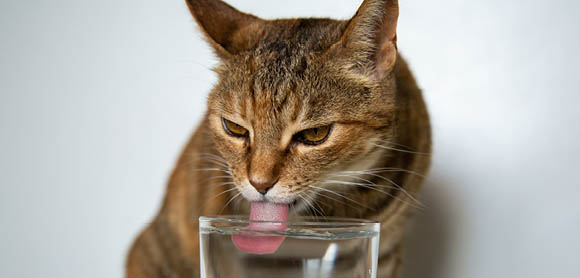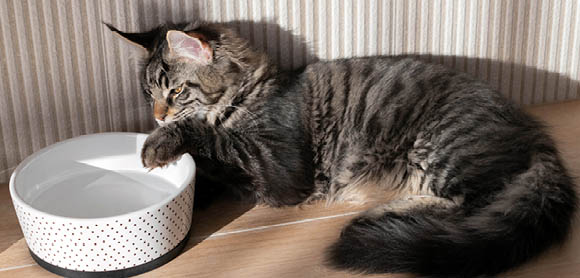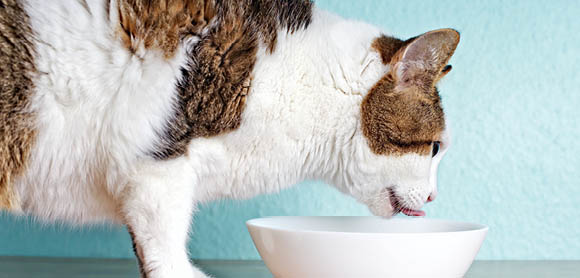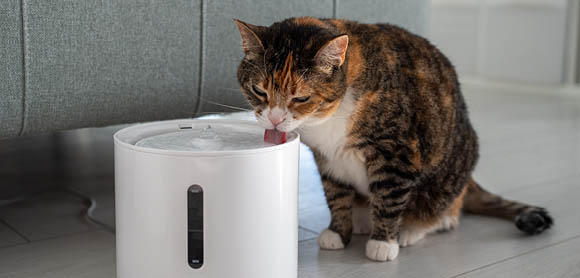Is your cat hydrated? And how do you know if they’re drinking enough? Discover how to recognise cat dehydration symptoms to keep your cat in optimum health.

Cats don’t naturally drink as much water as we might expect, but it’s still important to make sure they have access to plenty of fresh water when they are thirsty. If you’re able to recognise the signs of dehydration in cats, you can check your pet is getting enough water – even if you don’t see them drinking.
How do I know how much water my cat is drinking?
Domestic cats are descendants of wild cats who once roamed the deserts of the Middle East and Africa. These cats evolved to survive in an arid environment where water was scarce. That means, even now, our domestic cats still have a low thirst drive and don’t need to drink as often as we might expect.
Sarah Elliott, a vet from Cats Protection, says: ‘Owners often won’t see their cat drinking, as they can seek water from lots of places. Some like rainwater and drink from bird baths or puddles, while others like running water. Those on a wet-food diet may also drink less because they’re getting water from their food.’

Where should I put my cat’s water?
Offering lots of different water bowls in different locations can help to make sure your cat can drink as often as they want to. Place bowls around the house and garden – but away from the litter tray – ensuring your cat always has access to a variety of drinking options.
Keep food and water bowls separate, as cats don’t like food contaminating their water. It’s also best to choose a wide glass, stainless steel or ceramic bowl to stop your cat’s whiskers getting wet – and to stop bacteria multiplying, as it can do within scratches in plastic bowls.
Cats like to see what’s in front and behind them, too, so don’t put bowls in corners where they may not feel it’s a safe place to drink.
What if my cat is fussy about drinking water?
To understand how to get a cat to drink water, try adding a fishy ice cube to their water. Just dribble some of the excess liquid from a tin of tuna into a water-filled ice cube tray, freeze it, and pop one or two cubes in their water. Alternatively, add some fresh stock to the ice cubes by boiling chicken without salt.
Some cats like the feeling of trickling water from a water fountain, while others prefer filtered water. It’s worth experimenting with different water and bowl types to see which your cat prefers.
Can my cat drink too much?
Excessive drinking in cats can be a sign of diabetes or other health conditions. If you find yourself refilling their bowl more often or if your cat is starting to produce more urine in their tray, it’s best to schedule a vet check-up.

What causes dehydration in cats?
There are a number of issues that might cause dehydration, including:
- Diabetes
- Diarrhoea
- Fever
- Heatstroke
- Overheating in hot weather
- Trauma
- Vomiting
An excess of fluid loss means your cat will lack essential minerals in the body, such as sodium, potassium and chloride.
How to tell if a cat is dehydrated
While it’s not always obvious, there are many common cat dehydration symptoms to look out for:
- Cats who are mildly dehydrated will have tacky, almost sticky gums, compared with normal moist ones
- Gums may look paler than normal
- Loss of appetite
- Weakness and lethargy
- A more seriously dehydrated cat will display a skin tent – if you gently lift the skin between their shoulder blades, it takes a few seconds to lie flat again
- Increased heart rate
- Panting or drooling
- Trembling
- Change to urination patterns
- Sunken eyes that look sickly or abnormal
- Hot paws
- Collapsing (in severe cases)
Kidney problems can arise from cats not drinking enough, particularly in those aged 11 and over. However, any cat can get dehydrated.
If you’re at all worried, visit your vet. If you have Petplan cat insurance, you can also use our Pet Expert Chat to ask any questions about dehydration in cats. Simply log into your My Petplan account to access.

How can I stop my cat from getting too hot?
Cats can cope with the heat in warmer weather – a healthy cat will simply move to a cooler spot if they are getting too warm. However, cats will struggle when they can’t control where they go and don’t have the option to cool down – such as if they were to become trapped in a hot room, greenhouse, conservatory or car. Always check spaces like this to ensure your cat’s safety in warmer weather.
When it’s very hot, you can wrap a towel around a frozen water bottle for your cat to lie near, or buy them a cooling mat. You can also place a fan in a cool room. It’s important to know the signs of heatstroke to keep your cat safe, too.
How do you keep your cat hydrated? Share your suggestions on Petplan’s Facebook page
